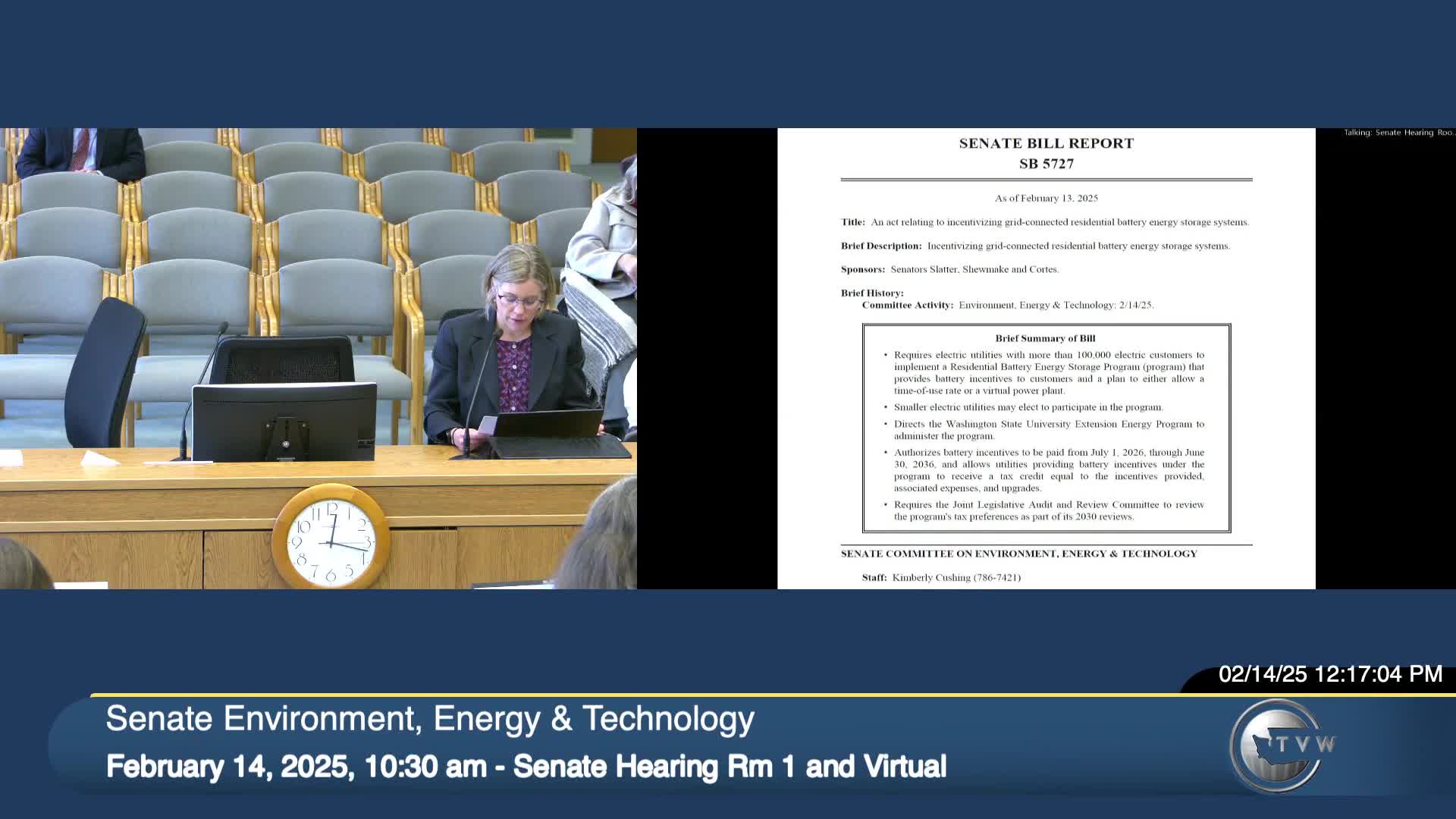Bill to incentivize grid‑connected residential batteries advances to broader review after hearing
February 14, 2025 | Environment, Energy & Technology, Senate, Legislative Sessions, Washington
This article was created by AI summarizing key points discussed. AI makes mistakes, so for full details and context, please refer to the video of the full meeting. Please report any errors so we can fix them. Report an error »

Senate Bill 5727, a measure to incentivize grid‑connected residential battery energy storage systems, was the subject of a public hearing in which sponsors and utilities discussed program design, eligibility, and rate structures. The bill would direct the Washington State University (WSU) Energy Program to administer a battery-incentive program and require large utilities (more than 100,000 retail customers) to participate; smaller utilities may opt in.
Key provisions (staff summary)
- Utilities must provide a one-time battery incentive to qualified customers (residential customers, nonprofits, public entities, tribal governments and academic institutions).
- Incentive levels in the bill text: up to $765 per kilowatt-hour for low-and-moderate-income customers and $450 per kilowatt-hour for other customers; each system is capped at 18 kilowatt-hours.
- Utilities must include program designs that either enroll customers in a time-of-use rate or incorporate the batteries into a utility-operated virtual power plant (VPP) so utilities can aggregate and manage distributed storage for grid benefit.
- Utilities may receive a public utility tax credit equal to battery incentive payments and associated costs; JLARC review of the tax preference is directed in the bill.
Why it matters: Sponsors described the bill as a way to strengthen household resilience to outages while allowing utilities to manage peak demand. The measure targets affordability barriers to battery adoption and would require further regulatory and program design work between utilities and the commission.
Testimony highlights
- Senator Slatter, sponsor in the Senate, described outages in her district during a recent storm and said distributed batteries can provide neighborhood-level resilience and assist utilities in reducing peak demand.
- Utilities (Puget Sound Energy, Avista and others) said they support the bill’s goals but requested flexibility in implementation, especially on rate design. Puget Sound Energy asked that rate-setting and value determinations not be overly prescriptive in statute because utilities and regulators must be able to design programs that fit different service territories and evolve with new data. Avista asked for a menu of options rather than forcing a single model and requested that pilots and existing learnings inform statewide design.
- Industry groups (Washington Solar Energy Industries Association and manufacturers/installers) and installers urged the committee to advance the bill and said that unlocking aggregated, grid‑interactive behavior for residential batteries is important to reap grid and customer benefits.
Positions and next steps
All parties signaled continued negotiations on technical language, especially around time-of-use rate design and the mechanics of utility-operated virtual power plants. Committee staff noted that certain program details — including rate designs and the value-of-solar and energy-storage accounting — require further regulator and stakeholder work before the program could be deployed at scale.
The committee took testimony and heard large‑scale stakeholder engagement; no committee vote was recorded at the public hearing stage.
Key provisions (staff summary)
- Utilities must provide a one-time battery incentive to qualified customers (residential customers, nonprofits, public entities, tribal governments and academic institutions).
- Incentive levels in the bill text: up to $765 per kilowatt-hour for low-and-moderate-income customers and $450 per kilowatt-hour for other customers; each system is capped at 18 kilowatt-hours.
- Utilities must include program designs that either enroll customers in a time-of-use rate or incorporate the batteries into a utility-operated virtual power plant (VPP) so utilities can aggregate and manage distributed storage for grid benefit.
- Utilities may receive a public utility tax credit equal to battery incentive payments and associated costs; JLARC review of the tax preference is directed in the bill.
Why it matters: Sponsors described the bill as a way to strengthen household resilience to outages while allowing utilities to manage peak demand. The measure targets affordability barriers to battery adoption and would require further regulatory and program design work between utilities and the commission.
Testimony highlights
- Senator Slatter, sponsor in the Senate, described outages in her district during a recent storm and said distributed batteries can provide neighborhood-level resilience and assist utilities in reducing peak demand.
- Utilities (Puget Sound Energy, Avista and others) said they support the bill’s goals but requested flexibility in implementation, especially on rate design. Puget Sound Energy asked that rate-setting and value determinations not be overly prescriptive in statute because utilities and regulators must be able to design programs that fit different service territories and evolve with new data. Avista asked for a menu of options rather than forcing a single model and requested that pilots and existing learnings inform statewide design.
- Industry groups (Washington Solar Energy Industries Association and manufacturers/installers) and installers urged the committee to advance the bill and said that unlocking aggregated, grid‑interactive behavior for residential batteries is important to reap grid and customer benefits.
Positions and next steps
All parties signaled continued negotiations on technical language, especially around time-of-use rate design and the mechanics of utility-operated virtual power plants. Committee staff noted that certain program details — including rate designs and the value-of-solar and energy-storage accounting — require further regulator and stakeholder work before the program could be deployed at scale.
The committee took testimony and heard large‑scale stakeholder engagement; no committee vote was recorded at the public hearing stage.
View full meeting
This article is based on a recent meeting—watch the full video and explore the complete transcript for deeper insights into the discussion.
View full meeting
